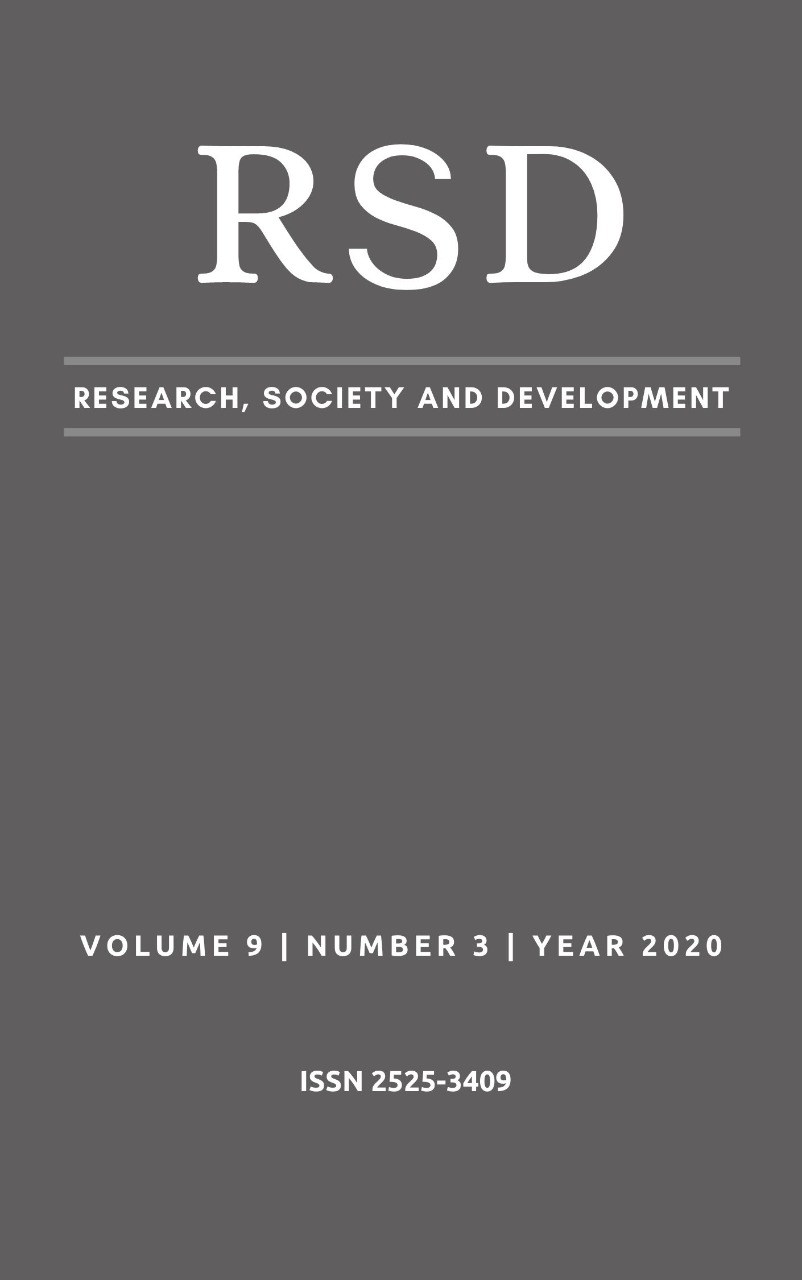Utilização de borrachas trituradas em formas granulares na compactação de solo: uma nova possibilidade para melhor destinação de resíduos
DOI:
https://doi.org/10.33448/rsd-v9i3.2345Palavras-chave:
Pneu triturado, Ensaio de compactação, Sustentabilidade.Resumo
Esta pesquisa tem por objetivo apresentar um estudo realizado experimentalmente do comportamento do solo com adição de borrachas trituradas, provenientes de pneus inservíveis, no intuito de promover uma nova destinação a estes resíduos sólidos. Adicionou-se às amostras de solo compactado percentuais de borrachas granuladas resultantes da trituração de pneus, sem a parte metálica de sua estrutura. Para simular a compactação de solos em obras de infraestrutura, especificamente de estradas, realizou-se ensaios de caracterização do maciço, sendo eles: a análise granulométrica, densidade real (DR), limite de liquidez (LL), plasticidade (LP), índice de plasticidade (IP) e ensaios de compactação (massa específica seca do solo e umidade ótima). Os ensaios foram padronizados possibilitando quantificar o comportamento no sentido de destinar esses materiais mantendo a qualidade inicial dos solos de Teresina, Piauí ou quaisquer outras regiões que tenham solos com características similares em que foram produzidos solos padrão (sem adição) e em misturas com 1% a 5% de borracha. Nos resultados observou-se que ao adicionar os percentuais não houve alterações consideráveis no grau de compactação do solo havendo a possibilidade de serem descartados em solos compactados sem que haja perda no desempenho e a qualidade do maciço. Dessa forma este seria um meio de descarte sustentável de borrachas com o propósito de reduzir os impactos ambientais que esses tipos de resíduos geram para o meio ambiente.
Referências
Associação Brasileira de Normas Técnicas. (2016). NBR 6457: Amostras de solo – Preparação para ensaios de compactação e ensaios de caracterização. Rio de Janeiro, 12p.
Associação Brasileira de Normas Técnicas. (2016). NBR 6459: Solo – Determinação do limite de liquidez. Rio de Janeiro, 6p.
Associação Brasileira de Normas Técnicas. (2016). NBR 7180: Solo – Determinação do limite de plasticidade. Rio de Janeiro, 7p.
Associação Brasileira de Normas Técnicas. (2016). NBR 7181: Solo – Análise granulométrica. Rio de Janeiro, 2016, 16p.
Associação Brasileira de Normas Técnicas. (2016). NBR 7182: Solo – Ensaio de compactação. Rio de Janeiro, 2016, 9p.
Brasil. (2009). Conselho Nacional do Meio Ambiente – CONAMA: Resolução nº 416. From http://www.mma.gov.br/port/conama/legiabre.cfm?codlegi=616
Brasil. IBGE. (2016). Brasil em síntese, de https://cidades.ibge.gov.br/brasil/pesquisa/22/0?ano=2016
Brasil. (2006). Ministério dos Transportes. Departamento Nacional de Infra Estrutura e Transportes. IPR-719: Manual de Pavimentação. (3), 274p.
Bosscher, P. J., Edil, T. B., & Eldin, N. (1993). Construction and performance of a shredded waste tire test embankment. Transportation Research Record, 99 (1345), 44-52. Retrieved from http:// https://trid.trb.org/view/370717
Canhada, J. C. S., Altran, D. A., Ishiki, H. M., Fidelis, G. N. S., & Santos, R. J. (2017). Caracterização física e morfológica de compósitos de concreto com resíduos de borracha vulcanizada. Colloquium Exactarum, 9 (3), 65-75. doi: 10.5747/ce.2017.v09.n3.e205
Departamento Nacional de Estradas e Rodagem. (1994). DNER-ME 093/94: Solos – Determinação da densidade real, 4p.
Franco, K. L. B. (2012). Caracterização do comportamento geotécnico de misturas de resíduo de pneus e solo laterítico. Dissertação de Mestrado, Departamento de Engenharia Civil, Universidade do Rio Grande do Norte, Natal-RN, 139p.
Lintz, R. C. C., & Mello, M. Y. C. (2008). Estudo das propriedades mecânicas de compósitos de cimento com borracha de pneus inservíveis. In: Congresso brasileiro de engenharia e ciência dos materiais., 18. Anais... Porto de Galinhas, 213-229.
Pierce, C. E., & Blackwell, M. C. (2003). Potential os scrap tire rubber as light weight aggregate in flowable fill. Waste Management, 23 (3), 197-208. doi:10.1016/s0956-053x(02)00160-5
Scagliusi, S. R. (2013). Recuperação/reciclagem de compostos de borrachas butílica e halobutílica por meio de radiação ionizante. Tese de Doutorado, Instituto de Pesquisas Energéticas e Nucleare – IPEN – USP. São Paulo, 207p.
Downloads
Publicado
Edição
Seção
Licença
Autores que publicam nesta revista concordam com os seguintes termos:
1) Autores mantém os direitos autorais e concedem à revista o direito de primeira publicação, com o trabalho simultaneamente licenciado sob a Licença Creative Commons Attribution que permite o compartilhamento do trabalho com reconhecimento da autoria e publicação inicial nesta revista.
2) Autores têm autorização para assumir contratos adicionais separadamente, para distribuição não-exclusiva da versão do trabalho publicada nesta revista (ex.: publicar em repositório institucional ou como capítulo de livro), com reconhecimento de autoria e publicação inicial nesta revista.
3) Autores têm permissão e são estimulados a publicar e distribuir seu trabalho online (ex.: em repositórios institucionais ou na sua página pessoal) a qualquer ponto antes ou durante o processo editorial, já que isso pode gerar alterações produtivas, bem como aumentar o impacto e a citação do trabalho publicado.


